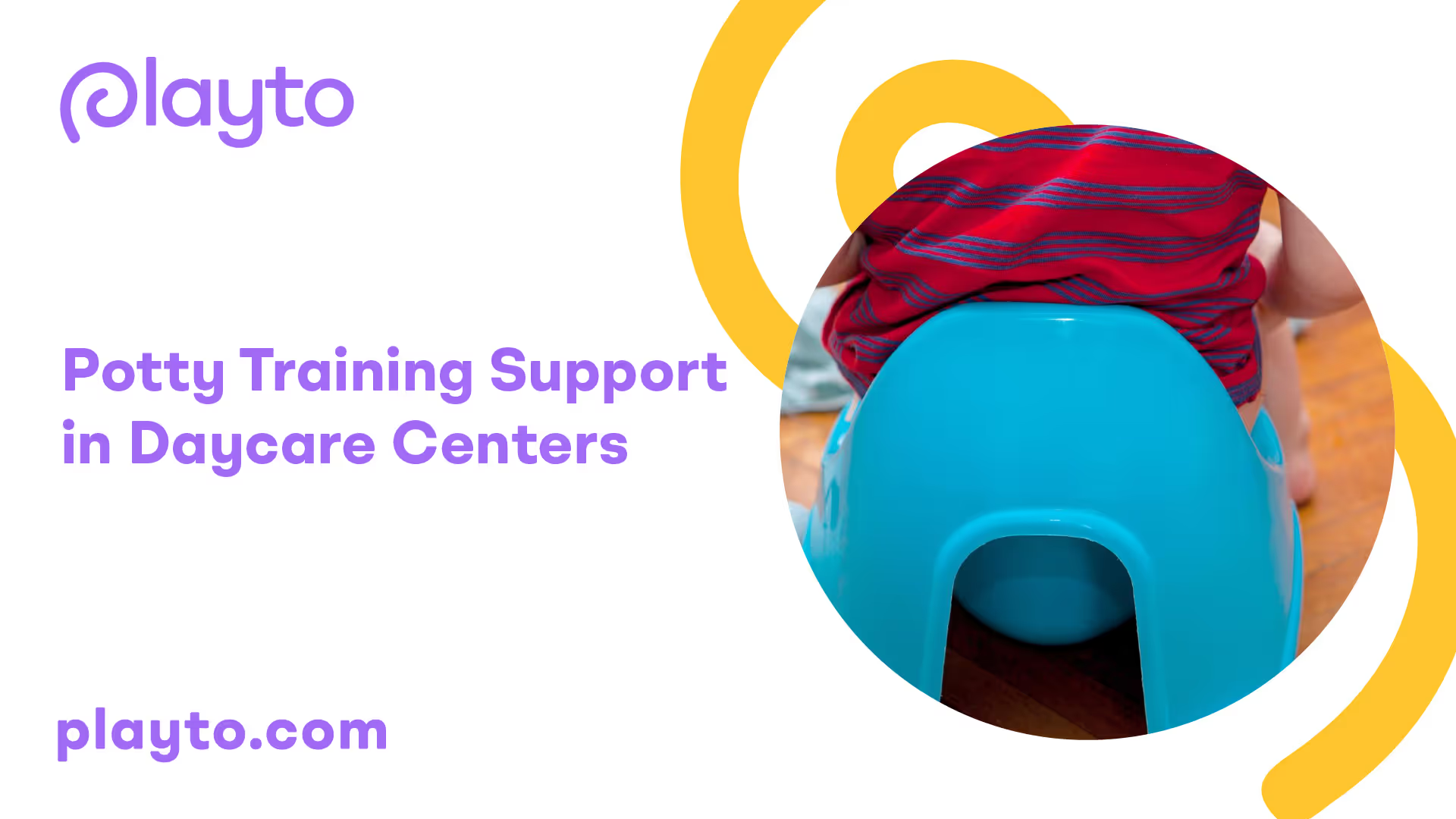Understanding Potty Training Support
When it comes to potty training, daycare centers play a significant role in providing support and assistance to children in this important developmental milestone. By understanding the role of daycare centers and maintaining consistency in potty training, children can have a positive and successful experience.

Role of Daycare Centers
Daycare centers serve as a crucial support system in the potty training process. They provide a structured environment where children can learn and practice using the toilet with guidance from experienced caregivers. Educators at daycare centers are trained to handle potty training and can offer valuable insights and strategies to both children and parents.
In daycare centers, children have the opportunity to observe and learn from their peers who are also going through the potty training process. This peer modeling can be a motivating factor for children and can help create a positive and encouraging atmosphere.
Consistency in Potty Training
Consistency is key when it comes to potty training, and it is important to maintain the same routine at home as well as in the daycare center. This means following the same timing for potty breaks and using the same type of toilet, such as a full-sized toilet with potty seats. Consistency helps children develop a sense of familiarity and comfort with the potty training process.
Open communication between parents and daycare providers is crucial for successful potty training. Parents should share information about their child's progress and any specific strategies that have been effective at home. On the other hand, daycare providers should provide feedback to parents on how potty training is going during the child's time at the center. This communication helps maintain consistency and ensures that everyone involved is working together towards the same goal.
By understanding the role of daycare centers and maintaining consistency in potty training, parents and caregivers can provide the necessary support for children to achieve success in this important milestone. For more information on potty training and other daycare-related topics, check out our articles on nap time policies in daycare: why they matter, communicating with your child's daycare provider, signs of a high-quality daycare center, and the cost of daycare: what to expect and how to budget.
Effective Communication in Potty Training
When it comes to potty training in daycare centers, effective communication between parents and caregivers plays a crucial role in ensuring a successful and consistent potty training experience for the child. In this section, we will explore two key aspects of communication: parent-caregiver communication and the use of positive reinforcement.

Parent-Caregiver Communication
Open and transparent communication between parents and daycare providers is vital in supporting potty training efforts. Parents should actively communicate with the daycare center, providing information about their child's progress and any specific strategies or techniques that have proven successful at home. Additionally, Brightwheel recommends providing caregivers with a report on how potty training went over the weekend when returning to daycare. This promotes consistency and ensures that everyone involved is on the same page.
Parents should take the initiative to inquire about the daycare's potty training policies during the selection process. Understanding the daycare's approach to potty training can help parents align their efforts at home with those of the daycare center. Establishing good communication with the daycare provider from the beginning is essential for successful potty training while the child is in daycare. For more information on communicating with your child's daycare provider, check out our article on communicating with your child's daycare provider.
Positive Reinforcement
Positive reinforcement is a powerful tool in potty training, and it's essential for both parents and caregivers to utilize this technique. Educators at daycare centers should avoid showing anger or frustration when accidents occur during potty training. Instead, they should reassure children that accidents happen and encourage them to try again. By maintaining a positive and supportive atmosphere, children are more likely to feel motivated and confident in their potty training journey.
Parents can also reinforce positive behavior at home by providing praise and rewards when their child successfully uses the potty. This positive reinforcement helps to reinforce the desired behavior and encourages children to continue their progress. It's important for parents and caregivers to communicate about the specific rewards or incentives being used, ensuring consistency between home and daycare.
By establishing open lines of communication and implementing positive reinforcement techniques, parents and daycare providers can work together to create a supportive environment for potty training. Setting clear expectations, educating parents on signs of readiness, and collaborating on a plan are all crucial components for a successful potty training process.
Remember, accidents may happen during the potty training process, and it's important to remain patient and understanding. By maintaining effective communication and using positive reinforcement, parents and caregivers can provide the support and encouragement needed for children to succeed in their potty training journey.
Overcoming Challenges in Potty Training
Potty training can present various challenges for both parents and daycare centers. Understanding and addressing these challenges is essential for successful potty training experiences. In this section, we will explore behavioral issues that may arise during potty training and strategies for overcoming them.

Behavioral Issues
During the potty training journey, some children may deliberately pee or poop their pants even when they know how to use the potty. This behavior is considered an intentional act rather than an accident [1]. It is important to differentiate between accidents and intentional defiance to effectively address the behavior.
To tackle this challenge, it may be helpful to offer a replacement behavior and consistently teach the child that peeing in defiance is not acceptable. Negative consequences, such as loss of privileges or temporary timeouts, might be more effective in changing this behavior. It is crucial not to reward or reinforce this behavior and to reinforce the message that peeing in defiance will not lead to getting what the child wants.
Additionally, finding alternative ways to address the behavior, such as using cloth underwear or making the act boring, can be more effective than putting the child back in diapers. It is important to tailor the strategies to the individual child and address any underlying medical issues that may contribute to the behavior [1].
Strategies for Success
Overcoming behavioral issues during potty training requires a combination of patience, consistency, and positive reinforcement. Here are some strategies that daycare centers can implement to support children in their potty training journey:
- Clear Communication: Ensure open and ongoing communication between parents and daycare providers. Regularly share progress, challenges, and strategies to maintain a unified approach towards potty training. For tips on effective communication, refer to our article on communicating with your child's daycare provider.
- Consistency: Consistency is key when it comes to potty training. Establish a consistent routine and approach across the daycare center, ensuring that all caregivers follow the same methods and reinforce the same expectations. Consistency helps children understand what is expected of them and promotes successful potty training.
- Positive Reinforcement: Celebrate and reward children's successes during potty training. Positive reinforcement, such as verbal praise, stickers, or small rewards, can motivate and encourage children to continue their progress. However, it is important to avoid excessive rewards that may create dependency or hinder natural motivation.
- Individualized Approach: Recognize that each child is unique and may require different strategies and timelines for successful potty training. Tailor the approach to meet the individual needs of each child, taking into account their temperament, developmental stage, and any specific challenges they may face.
By addressing behavioral issues and implementing effective strategies, daycare centers can provide the necessary support for children during the potty training process. This collaboration between parents and caregivers helps create a consistent and positive environment, facilitating successful potty training outcomes.
Readiness and Approaches to Potty Training
Before embarking on the potty training journey, it is important to assess a child's readiness and consider the different approaches that daycare centers may employ to support this process.
Signs of Readiness
Recognizing the signs of readiness is crucial when determining if a child is ready to begin potty training. While the timing may vary for each child, there are common indicators to look out for. Some signs of readiness include:
- Showing an interest in the bathroom and toilet activities.
- Demonstrating the ability to follow simple instructions.
- Exhibiting awareness of bodily functions, such as indicating when they have soiled their diaper.
- Displaying physical readiness, such as being able to sit on a potty chair or toilet with support.
- Having consistent and predictable bowel movements or dry periods for at least two hours.
It is important to note that not all children will exhibit all of these signs simultaneously. However, observing a combination of these signs can indicate that a child is ready to start the potty training process.
Curriculum Integration
Daycare centers play a vital role in supporting children during the potty training journey. They often integrate potty training into their daily routines and activities. Here are a few ways daycare centers may approach potty training:
- Potty Books and Visual Aids: Daycares tend to have a stash of potty books available to help children get used to the idea of using the toilet. Visual aids, such as charts or posters, may also be used to provide a visual representation of the potty training process.
- Sticker Charts and Rewards: Daycares may use sticker charts in the bathroom as a reward system for children who sit on the potty. Children are often given the opportunity to put a sticker on the chart themselves, which can serve as positive reinforcement for their efforts [2].
- Establishing Regular Bathroom Breaks: Daycares have their own approaches to scheduling bathroom breaks. Some may implement a toilet routine four times a day, while others may take children to the potty every half-hour. These regular breaks help establish a routine and provide opportunities for children to practice using the toilet [2].
- Adapting to the Environment: Daycares often work around any obstacles they may encounter when it comes to potty training. For instance, if only full-sized toilets are available, they may avoid using toilet inserts due to difficulties in keeping them clean. They find ways to accommodate the child's needs and create a supportive environment [2].
- Collaboration with Parents: Daycare centers understand the importance of effective communication and collaboration with parents during the potty training process. They may provide updates on the child's progress, share insights, and seek parental input to ensure consistency between home and daycare practices. For tips on communicating with your child's daycare provider, refer to our article on communicating with your child's daycare provider.
By recognizing signs of readiness and integrating potty training into their daily routines, daycare centers can provide the necessary support and structure to help children successfully navigate the potty training process.
Daycare Center Practices
When it comes to potty training, daycare centers play a vital role in providing support and guidance to children and their parents. Two key aspects of daycare center practices in potty training are handling accidents and setting clear expectations.
Handling Accidents
Accidents are a common part of the potty training process, and it's important for daycare centers to handle them with patience and understanding. Educators should avoid showing anger or frustration when accidents occur, as this can create anxiety and hinder a child's progress. Reassuring children that accidents happen and encouraging them to try again is crucial in building their confidence.
Daycare centers should have appropriate protocols in place for handling accidents. This includes having a designated area for changing clothes, providing extra clothes for children, and following proper hygiene practices when cleaning up. By responding to accidents calmly and providing support, daycare centers can help children feel comfortable and confident during the potty training process.
Clear Expectations
Setting clear expectations is essential for successful potty training in daycare centers. Daycare providers should communicate their expectations to both children and parents, ensuring everyone is on the same page. Clear expectations include guidelines for when children should use the potty, how they should clean themselves, and when to ask for help.
By establishing consistent routines and schedules, daycare centers can create an environment that supports potty training. This may include regular bathroom breaks, encouraging children to try using the toilet before and after activities, and reinforcing good hygiene practices.
Furthermore, it's important for daycare centers to communicate with parents regarding their expectations and progress. Regular updates and open lines of communication help parents stay informed about their child's potty training journey and enable them to provide consistent support at home. For tips on effective communication between parents and daycare providers, refer to our article on communicating with your child's daycare provider.
By prioritizing accident handling and establishing clear expectations, daycare centers can create a supportive environment for potty training. While policies regarding potty training may vary between daycare centers, it's important to find a center that aligns with your goals and values. For more information on signs of a high-quality daycare center, check out our article on signs of a high-quality daycare center.
Collaboration and Transition
When it comes to potty training in daycare centers, a collaborative approach between parents and daycare providers is key to ensure a smooth transition and successful potty training experience for the child. By establishing a strong parent-daycare partnership and implementing a smooth transition process, both parties can work together towards achieving potty training milestones.
Parent-Daycare Partnership
Parents play a vital role in supporting their child's potty training journey, both at home and in the daycare setting. To ensure a seamless transition, it is recommended that parents communicate with both their child and the daycare provider about how potty training should be managed. This includes discussing the child's progress, preferences, and any specific strategies that have been effective at home.
During daycare interviews or registration, it is essential for parents to inquire about the daycare's potty training policies. By understanding and aligning with the daycare's approach, parents can effectively reinforce consistent potty training practices at home. Clear and open communication between parents and daycare providers is crucial in addressing any concerns, sharing progress updates, and ensuring a collaborative approach to potty training.
Smooth Transition Process
The transition from at-home potty training to daycare training can sometimes pose challenges. However, with proper planning and communication, this transition can be made smoother for the child. It is recommended that parents designate a specific caregiver at the daycare who will take charge of the child's potty training responsibilities.
By designating a caregiver, parents can ensure that the child has a consistent point of contact for potty training-related activities. This caregiver can take the child to the potty at regular intervals, observe signals, and assist in case of accidents. Sharing the child's potty training intervals and signals with the caregiver helps maintain continuity between home and daycare.
To support a successful transition, parents can also introduce potty training at home and provide signals to the daycare to help facilitate the process. This collaborative effort allows the daycare to incorporate potty training practices into the child's routine, even if the child is not showing signs of readiness according to traditional standards.
By establishing a strong parent-daycare partnership and implementing a smooth transition process, potty training in daycare centers can be a positive and successful experience for both the child and the caregivers involved. Effective collaboration and communication between parents and daycare providers are essential in ensuring consistent potty training practices and supporting the child's developmental milestones.
